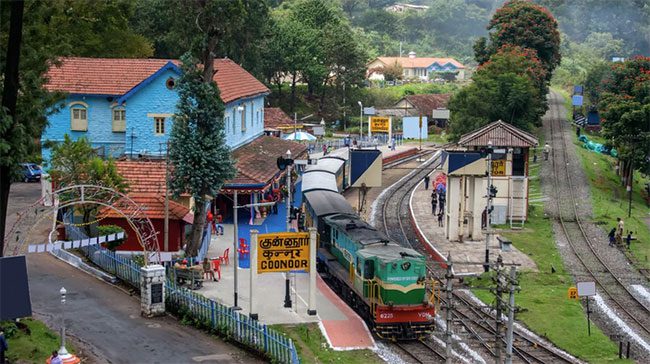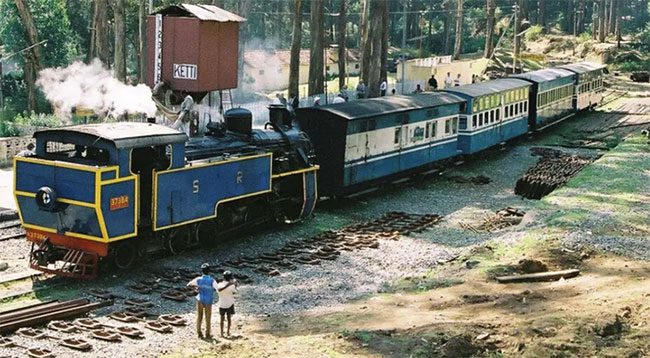The Nilgiri Mountain Railway, also known as NMR, is a train journey that appeals to travelers who enjoy uninterrupted journeys while taking in unfamiliar and captivating sights.
This could be considered the slowest train in India as it traverses the state of Tamil Nadu, where the tracks have an extremely steep gradient. It takes about 5 hours to cover the 46 km route from Mettupalayam at the foot of the Nilgiri Hills to Udhagamandalam, commonly referred to as Ooty. The return journey downhill takes only 4 hours.

This train is for travelers who enjoy viewing unfamiliar and captivating sights.
According to UNESCO, this railway line ranges in altitude from 326 meters to 2,203 meters. Certain segments of the route are so steep that a special rack and pinion system is used to allow the train to continue its journey.
The Nilgiri Mountain Railway departs from Mettupalayam at 7:10 AM and arrives in Ooty at 12:00 PM. On the return trip, the train leaves Ooty at 2:00 PM and arrives back in Mettupalayam at 5:35 PM.

First-class ticket prices for the train are 600 rupees (over 172,000 VND).
Onboard, time seems to stand still
People choose this railway not just for transportation, but because they enjoy the experience of sitting on a train that passes through 16 tunnels, 250 bridges, and 208 curves in the Western Ghats – a UNESCO World Heritage site and a hotspot for biodiversity. The first-class ticket costs 600 rupees (over 172,000 VND), while the economy class ticket is less than half the price, but seating is not cushioned.
D. Om Prakash Narayan, a senior public relations officer at Southern Railway, describes: “Stepping onto the train feels like entering another dimension.” Onboard, many families sit crowded by the windows, eagerly anticipating the exciting journey ahead. The atmosphere is filled with excitement as passengers cheer and clap when the train passes through dark tunnels.
Ooty is one of the oldest hill stations in India and has long been a popular tourist destination. After passing through Ooty, travelers will encounter stations with English names, evoking memories of a bygone era.

Farmers working on tea plantations.
Sharanya Sitaraman, a passenger on the train, shares her thoughts: “Everything seems almost unchanged from the colonial times, as if time has stopped here. We can imagine a European woman in a fancy hat stepping down from the train at this station.”
Retired journalist D. Radhakrishnan, who specializes in reporting on Nilgiri, states: “Passengers on the train can still feel the scenery of 100 years ago.”
Narayan, a railway veteran with over 30 years of experience, adds: “Ooty and Coonoor have been exploited for natural resources for development purposes, and you can feel the human impact if you walk around. But from the train, everything looks very pristine.”
The train passes through tea plantations and waterfalls that appear after summer rains. Outside the window, there are winding curves, with the occasional sighting of bison or elephants in the bushes. When the train stops at a station, passengers disembark to relax a bit and take photos of the station. The train will stop longer at Coonoor station to change the diesel locomotive (used on flat terrain) to a steam locomotive for added power on the slopes. Vendors along the route are often present at stops to serve hot tea and masala vada (a traditional Indian snack).
Sometimes, the tranquil scenery and gentle rocking of the train will help passengers drift off to sleep.
Subha J Rao, a journalist from Mangalore, also has many childhood memories of train journeys. She recalls: “We could get off the train and walk alongside it. As children, we loved playing with the soot and smoke coming from the engine.”
In conclusion, this journey is like a remedy for those who want to escape the noisy and bustling city life to experience a slower pace, just like the literal speed of the train.


















































